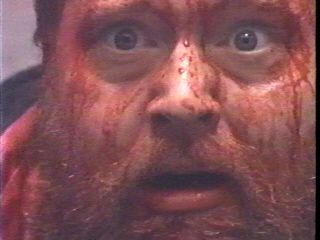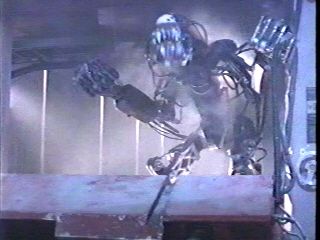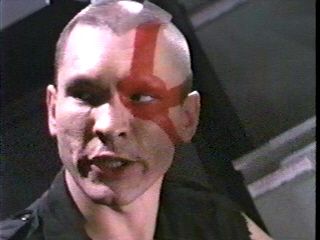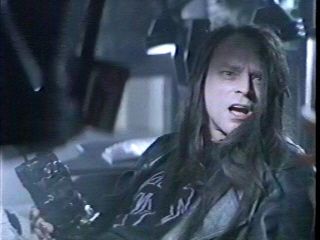
|
|
|
|
|
|
|
|
|
|
|
|
|
(1995) Director: Stephen
Norrington
It was some time ago - 212 reviews ago to be exact, when I reviewed Act Of War - where I declared I was sick and tired of Die Hard clones, and that I was going to lay off the genre for a while. More specifically, I was sick of bad Die Hard clones, and I may not have avoided the genre for so long if I had previously found that a reasonable number of these movies were actually good. Consequently, I managed to avoid the genre the best I could, only acknowledging it when the particular movie I was watching unexpectedly changed tactics and snuck in some Die Hard action, such as with the movie Chain Of Command. Aside from a few exceptions like that, I didn't mull the Die Hard genre at all until recently, when I stumbled across a copy of Death Machine in the sci-fi section at a video store when trying to find a sci-fi movie that I could review and add to the meagre selection I currently offer. (In my defense: Have you ever noticed how pitiful the number is of sci-fi movies that are available to rent at a typical video store?) Looking at the movie, I figured probably enough time had
gone by so that I could review another Die Hard clone,
especially since I Another way that Death Machine is different from other Die Hard clones is that it's one of the few that's not American. It is actually a British production, though it is set in the United States. Though this does inevitability lead to the accents of the predominantly British cast slipping through on occasion, it also gives the movie a somewhat different feeling, since it's being done by people who grew up in a different culture. That's evident right from the beginning, where the movie eschews the standard practice of immediately titillating the audience by opening with fairly gratuitous action, to instead setting up the situation with a sequence that aims to be disturbing and haunting. The opening has armed agents from Chaak Industries - a multinational technological firm - tracking down a combat cyborg that went renegade on them. They do manage to find the cyborg more or less still functioning - though they find it right in the middle of a desert diner where moments before it had massacred practically everybody inside. Though Chaak tries to cover it up, the tragedy manages to leak out to the press all the same, and everyone from the government to the common citizen voices their fury and demands that the shadowy Chaak be thoroughly investigated. Some select citizens are not content to wait for an
investigation, feeling that Chaak's top C.E.O.s - John Carpenter
(Hootkins) and Scott Ridley (Richard Brake) We obviously have an appropriate setting and situation for lots of Die Hard mayhem from this point on. Curiously though, the movie isn't quite as action-packed as you might think. For one thing, the first serious action sequence doesn't happen until about half an hour after the movie has begun. And that first action sequence actually happens fifteen or so minutes before the point mentioned in the previous paragraph where Cale and the terrorists realize they must work together. From there on, the subsequent action does occur more frequently, but it's definitely not at the breakneck rate found in Die Hard and many of its clones. It goes to show that the traditional style of movies being a kind of illustrated radio has not completely disappeared from our British cousins, since obviously the stuff between the sporadic action is a lot of talk. But in this case, the dialogue is not the typical long-winded, thousand words worth a single picture kind of talk. When characters discuss what they should do or how they are feeling, they not only talk in a common-man style that is comfortable to the ear, they get right to the point in whatever they are discussing. This is dialogue that actually moves, actually advancing the story as well as being in itself interesting to listen to. What really makes the dialogue sparkle is that a good deal of humor has been placed in it. Since this is ostensibly a sci-fi action movie, most of the characters have wisely been given humorous dialogue that's somewhat subtle, so that the movie can remain a sci-fi action movie instead of becoming a sci-fi action comedy - a tone that would be disastrous when trying to fit it with the movie's occasional scenes of violent and bloody mayhem. Still, the movie does have its share of wackiness, and these sporadic moments do provide some welcome laugh-out-loud moments. That the terrorists keep calling the overweight Carpenter "Ho-Ho" may be a cheap gag, but I admit that it always made me laugh, particularly in the way they kept yelling it at him. Practically all the performers get the chance to show
off a little humor, each in a different tone that is appropriate for
their character and their The dark side to Dourif's character is also a handy device for director Norrington (Blade) to use during the first part of the movie, to warm us up for the subsequent mayhem to come. Dourif's creepy and secretive character is a reminder that there is something creepy and secretive going on just below the surface, and soon it will burst out and spread havoc. It is kind of a shame that when the havoc does eventually break through, Dourif's character is more or less put on the back burner, and even forgotten about for long periods of time. This is adequately compensated, however, by the fact that all the action sequences are very well done. True, the low budget is evident in the beginning; for a long time we see nothing of the Warbeast, just P.O.V. shots from its camera eyes, and when it breaks through walls we just see dust and rubble that it generates from this destruction, and nothing of the robot itself. Yet it's effective, because we always get some sense of relenting menace - for example, the P.O.V. shots always show the Warbeast running down the skyscraper corridors at a breakneck speed that would exhaust the Terminator. All this builds the sense of danger, so when we start seeing more of the robot, such as when a gigantic Freddy Krueger-like claw bursts out of an elevator floor, the impact then is greater than if we saw it right from the beginning. The subsequent use of mechanical effects is excellent, using some life-sized mechanical puppetry to miniatures when we see the entire Warbeast. It's amazing how good these effects look; they look good enough for the big screen. The whole movie looks good; it's obvious that
Norrington is a very resourceful director, to manage to accomplish so
much on a limited budget. The movie would UPDATE: I got this information from Chris Seay: "I managed to find the extremely hard-to-find
Japanese laserdisc of this
Check for availability on Amazon (VHS) See also: Automatic, Point Blank, Robotrix |
 knew this particular one was
pretty good, having already watched it several years before. Another
reason why I felt Death Machine
would be worth writing about is that it is a somewhat more original
take on the old formula. For one thing, it isn't another case of one
man being pursued by a group of terrorists or bad guys of a similar ilk
- this time around it's the
terrorists who are the protagonists, and they and a couple of other
people are running around the building being pursued by an enemy
consisting of one man. Well, make that one man and his
"Warbeast", the latter of which could be best described as a quick and
nimble humanoid-shaped steam shovel with a
very bad attitude. As you may have guessed, the movie doesn't just
borrow from Die Hard, but also from The Terminator,
seeing how the enemy here is a seemingly indestructible robot that is
relentless in its pursuit to eliminate the enemy it's been programmed
to destroy. For that matter, the movie also borrows heavily from the
Alien series,
Predator, and Robocop. So this movie is even
less original with its ideas than your typical Die Hard clone.
However, to its credit the movie manages to take all these ideas and
fuse them together so that it becomes its own. You can see the
influences, yes, but at the same time it puts its own twists on them so
that the end result actually seems less of a rip-off than it actually
is.
knew this particular one was
pretty good, having already watched it several years before. Another
reason why I felt Death Machine
would be worth writing about is that it is a somewhat more original
take on the old formula. For one thing, it isn't another case of one
man being pursued by a group of terrorists or bad guys of a similar ilk
- this time around it's the
terrorists who are the protagonists, and they and a couple of other
people are running around the building being pursued by an enemy
consisting of one man. Well, make that one man and his
"Warbeast", the latter of which could be best described as a quick and
nimble humanoid-shaped steam shovel with a
very bad attitude. As you may have guessed, the movie doesn't just
borrow from Die Hard, but also from The Terminator,
seeing how the enemy here is a seemingly indestructible robot that is
relentless in its pursuit to eliminate the enemy it's been programmed
to destroy. For that matter, the movie also borrows heavily from the
Alien series,
Predator, and Robocop. So this movie is even
less original with its ideas than your typical Die Hard clone.
However, to its credit the movie manages to take all these ideas and
fuse them together so that it becomes its own. You can see the
influences, yes, but at the same time it puts its own twists on them so
that the end result actually seems less of a rip-off than it actually
is. are thoroughly
corrupt. So a self-proclaimed humanitarian terrorist team make plans to
sneak into the Chaak skyscraper and destroy their files, and the
operation is lead by two young hotshots named Yutani (Martin McDougall)
and Sam Raimi (John Sharian). (Yes, I get all these in-jokes with the
names of all the characters - you don't have to tell me.) What the
terrorists don't know is that Hayden Cale (Pouget), Chaak's
newly-appointed C.E.O., is a woman with a conscious, and she is
determined to get Chaak to clean up its act and make a full disclosure
of all its activities, whether they are illegal or not. This doesn't
sit will with Carpenter and Ridley, and especially doesn't sit well
with Jack Donte (Dourif), the insane genius living in the basement
whose frequently illegal activities and creations have made the company
the success it has been. All the same, Cale wastes little time with the
psychotic and lusting Donte when they first meet, and later that night
fires him, blocking off his access to his laboratory - seconds before
the humanitarian terrorists storm the Chaak building and wrestle
control from Cale. But the vengeful Donte quickly gets control of
the previously mentioned Warbeast machine, and lets it loose against
Cale and the terrorists - and now they are forced to put aside their
differences if they want to stay alive.
are thoroughly
corrupt. So a self-proclaimed humanitarian terrorist team make plans to
sneak into the Chaak skyscraper and destroy their files, and the
operation is lead by two young hotshots named Yutani (Martin McDougall)
and Sam Raimi (John Sharian). (Yes, I get all these in-jokes with the
names of all the characters - you don't have to tell me.) What the
terrorists don't know is that Hayden Cale (Pouget), Chaak's
newly-appointed C.E.O., is a woman with a conscious, and she is
determined to get Chaak to clean up its act and make a full disclosure
of all its activities, whether they are illegal or not. This doesn't
sit will with Carpenter and Ridley, and especially doesn't sit well
with Jack Donte (Dourif), the insane genius living in the basement
whose frequently illegal activities and creations have made the company
the success it has been. All the same, Cale wastes little time with the
psychotic and lusting Donte when they first meet, and later that night
fires him, blocking off his access to his laboratory - seconds before
the humanitarian terrorists storm the Chaak building and wrestle
control from Cale. But the vengeful Donte quickly gets control of
the previously mentioned Warbeast machine, and lets it loose against
Cale and the terrorists - and now they are forced to put aside their
differences if they want to stay alive. situation. As the top C.E.Os,
Hootkins is amusing in his befuddlement, and Brake is deliciously slimy
as the top C.E.O., so sneery and sarcastic against everything that
poses a problem to him that you just have to laugh at his disgust.
McDougall and Sharian play their characters as ones who have not
completely left their adolescence behind, and when it comes out during
some aggravating moments it also provides some comic relief. McDougall
also provides extra amusement with his character's samurai-like
behavior, whether it is making guttural noises like a martial arts
master, or ritualistically sticking his hand in his pants and ripping
off his underwear so he can make an emergency bandage. As good as those
actors are, they are no match for the real star of this movie. The
standout performance actually belongs to Dourif, who steals the show
with his character's outrageous behavior. His character's insanity
provides a lot of comedy, whether he is imitating Sylvester the cat, or
rationalizing Pouget's pointing a gun at him as it being her "time of
the month." Yet at the same time you sense a dark side to his
character; witness his first scene, where his insane ranting to Pouget
slowly becomes more and more threatening with each subsequent sentence
he utters to her. This isn't just a great B movie performance - this is
a great performance, period, and Dourif deserves praise for his great
acting here.
situation. As the top C.E.Os,
Hootkins is amusing in his befuddlement, and Brake is deliciously slimy
as the top C.E.O., so sneery and sarcastic against everything that
poses a problem to him that you just have to laugh at his disgust.
McDougall and Sharian play their characters as ones who have not
completely left their adolescence behind, and when it comes out during
some aggravating moments it also provides some comic relief. McDougall
also provides extra amusement with his character's samurai-like
behavior, whether it is making guttural noises like a martial arts
master, or ritualistically sticking his hand in his pants and ripping
off his underwear so he can make an emergency bandage. As good as those
actors are, they are no match for the real star of this movie. The
standout performance actually belongs to Dourif, who steals the show
with his character's outrageous behavior. His character's insanity
provides a lot of comedy, whether he is imitating Sylvester the cat, or
rationalizing Pouget's pointing a gun at him as it being her "time of
the month." Yet at the same time you sense a dark side to his
character; witness his first scene, where his insane ranting to Pouget
slowly becomes more and more threatening with each subsequent sentence
he utters to her. This isn't just a great B movie performance - this is
a great performance, period, and Dourif deserves praise for his great
acting here. have looked even better had I been
able to find a letterbox version of it; as it was, I could not see the
scope of the action, and there are plenty of awkward moments when
characters are cut off by the sides of the screen. Speaking of things
getting cut off, even if I didn't know beforehand that several minutes
of the movie were cut out when it reached these shores, it would still
be easy to tell that the movie seems unnaturally rushed at times, with
little to no explanation about certain things. These are definitely not
the only problems to be found in Death Machine, but for
every problem that comes up, there are several little neat touches to
compensate for them. I liked how, in the incredibly tense and
relentless final sequence, Norrington sneaks in a couple of chances for
the audience to catch its breath (and even laugh a little.) Also that
Norrington handles the fates of Donte and the Warbeast in an
unforgettable yet more thoughtful manner. Little touches here and there
that are, believe it or not, human. I'm not saying that
Death Machine is some kind of revolutionary masterpiece, but
it's got the right things that a B movie should have: entertainment as
well as imagination.
have looked even better had I been
able to find a letterbox version of it; as it was, I could not see the
scope of the action, and there are plenty of awkward moments when
characters are cut off by the sides of the screen. Speaking of things
getting cut off, even if I didn't know beforehand that several minutes
of the movie were cut out when it reached these shores, it would still
be easy to tell that the movie seems unnaturally rushed at times, with
little to no explanation about certain things. These are definitely not
the only problems to be found in Death Machine, but for
every problem that comes up, there are several little neat touches to
compensate for them. I liked how, in the incredibly tense and
relentless final sequence, Norrington sneaks in a couple of chances for
the audience to catch its breath (and even laugh a little.) Also that
Norrington handles the fates of Donte and the Warbeast in an
unforgettable yet more thoughtful manner. Little touches here and there
that are, believe it or not, human. I'm not saying that
Death Machine is some kind of revolutionary masterpiece, but
it's got the right things that a B movie should have: entertainment as
well as imagination.